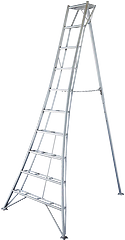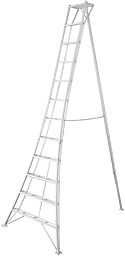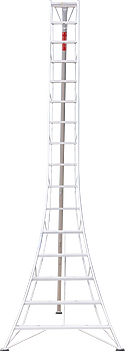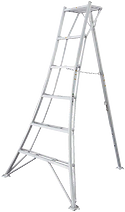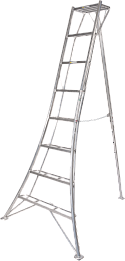Which ladder to choose? Good question, without a straightforward answer. Every garden, every gardener and every job is slightly different and what works for one might be less suitable for another, BUT, there are a few basic truths…
Original or EN Pro Adjustable:
The heavy duty EN Pro Adjustable Tripod Ladders are designed for landscapers, tree surgeons and other tough jobs - but do perfectly well in private gardens. If the ladders are used by employees, or will be taking a heavy weight of more than 100kg, or used intensively, day in, day out, they are essential, even without the adjustable legs. Consider it a beefed-up version of the original Tripod Ladder, conforming to EN-131 standards, assuring professionals, employers and all demanding gardeners of the quality and safety of these remarkable ladders. With a load bearing of 150kg, reinforced lower rungs and a chunkier back leg, it is stronger, more robust, and more rigid, offering greater stability and user safety. For regular domestic use, the Original Tripod Ladder will do you fine - although it is not suitable, or rated, for trade or commercial use. If you need the adjustable front legs - for full versatility - go for the EN Pro Adjustable.
Size:
Using our SSH (Safe Standing Height) combined with your own height, and the height of the job in hand, we can fairly accurately say what size ladder you need (for a specific job). On the larger ladders (7' and up) the SSH is 3 steps from the top, so the top is effectively your handrail or something to lean against. On the smaller ladders, the SSH is officially 2 steps from the top, but for more cautious users we still recommend 3. So, using the 8 footer as an example, you can stand, comfortably and safely, at 5'. Let’s say you’re 6' tall, which means the top of your head is at 11' and you can reach to about 12', arm outstretched. For hedge pruning, where ideally you want to be working between waist and chest height, you’ll have a working height of 8-10'. Of course it’s higher if you’re taller than 6', and lower if shorter.
The ANSI 15' Tripod Ladder is enormous - far too big for most gardens, and very hard to manoeuvre. We only deliver this ladder in our own vehicle. Please contact us to discuss, before ordering.
Weight:
They’re all remarkably light, and folded up into a lump of aluminium, in a suitcase, would seem like nothing at all. What they are, though, is tall, and wide. Moving them around, especially when you’re deep in the undergrowth and you need to move a few feet, can be tricky: the legs stick out wider than you think, and the taller ladders can be top heavy. Taller people tend to hold the ladder higher up, so this is less of a problem - for shorter people it can be a real bore. Keiko, who is Japanese-height, finds using the 8 footer fine, but not the 10 footer.
All-rounder:
Just like everything else, there’s no such thing as the perfect all-round ladder (even though we like to think we get pretty close.) If your ladder is for one job - great. If it’s for general use, there are a couple of points to consider. If you think you need the biggest one, think again. It will be great for a few jobs, but it will be OTT for lots more: we always suggest getting the size that will get the most use, and point out that even if you get the biggest, it still won’t be big enough for some jobs. Personally, my favourite ladder is the 7' Adjustable (and you can guess how many I have to choose from). Think also about where the ladder will live, whether it will travel, and who else might use it.
Slopes:
All the tripod ladders have an adjustable back leg, with a spring-pin that extends (by 6") or shortens (upto 18") in 6" stops. So working into a slope is fine (always try and work into, not down, the slope). The EN Pro Adjustable has adjustable front legs too, adjusting in 5cm increments to cater for sideways level changes of up to 40cm.
Load Bearing:
- Original Tripod Ladder: 100kg
- EN Pro Adjustable Tripod Ladder 150kg
Three legs, wide base, no wobble
Our ladders are carefully crafted with safety, stability, durability, and manoeuvrability in mind. Whether you’re pruning a tree, shaping a box hedge, or cleaning the gutters, a safe, stable setup makes all the difference, but like any well-made tool, it must be used with care.
Take a moment to read through these tips, even if you’ve had the ladder for a few years. It’s mostly common sense, but there are a few things worth knowing to help you get the best out of your ladder – and feel safe while doing so.
While aluminium ladders are known for their rust and corrosion resistance they can still deteriorate over time. Factors like prolonged exposure to harsh weather, improper storage, and wear and tear can lead to damage and reduced stability, so this is important stuff:
Using your ladder for the first time:
- Unpack the ladder and remove the protective wrapping from the clawed feet and other parts.
- Look over the ladder to check for any damage before use. If you spot anything unusual, give us a call.
When not to use the ladder:
- If any of the legs, steps, or welded joints are bent, dented, twisted, or otherwise damaged.
- If the pin or safety chain isn’t intact.
- If the clawed feet feel loose or broken.
Setting up the ladder:
- Double-check for any damage (see above).
- Make sure all moveable parts open and close smoothly - if the legs feel stiff or stuck, check for mud or dirt blocking the way.
- Ensure the safety chain is securely attached to the ladder body and can connect to the hook on the third leg.
- Test the extendable third leg and spring pin to make sure they lock and release correctly. If not, please don’t use the ladder.
Climbing the ladder:
- Only one person on the ladder at a time.
- Wear slip-resistant, closed-toe shoes.
- The clawed feet are suited to soft ground, grass, and soil, but be sure to use the optional rubber feet on timber, concrete, or other hard surfaces.
- Adjust the third leg so the steps are level and lock the pin securely.
- Make sure the third leg is fully perpendicular to the main ladder.
- Never climb higher than the third step from the top (or the second step on ladders under 2m).
- Check your surroundings for hazards like overhead cables, or uneven ground.
- Always face the ladder, using both hands and feet when climbing up or down.
- Lean against the steps to gain better balance and work safely.
- When working on a slope, adjust the third leg so you’re always working uphill.
Regular Checks:
- Keep your ladder clean and dry, and ensure all moveable components are working as they should. If anything feels stiff or stuck, check for obstructions.
- Inspect all components for signs of damage or corrosion.
- Make sure the third leg is undamaged (not twisted) and can be positioned fully perpendicular to the main ladder.
- Check that the pin and safety chain are both present and intact.
- Inspect the clawed feet. Do not use the ladder if they feel loose or damaged.
Transporting the ladder:
- Never carry the ladder by the third leg. Always secure the third leg on the retaining bracket before lifting.
- Be aware of your surroundings to avoid accidents or damage to people and property.
- If attaching to a vehicle, avoid pulling straps too tightly over the third leg as this may cause damage.
Maintenance:
- Keep your ladder clean and free from grease, oil, mud, and water.
- Use a gentle cleaner or detergent to remove dirt, and dry the ladder before use.
- Don’t leave detergent or cleaning fluid on the ladder without wiping it off. This can cause corrosion.
Storage:
- Store the ladder in a dry, sheltered place, out of direct sunlight or rain. Make sure it’s dry before putting it away.
- Never store anything on or stacked against the ladder – this could cause damage.
- Avoid storing the ladder near agricultural chemicals, cement, or lime products, which can corrode metal.
Common sense safety:
- If your ladder is damaged, please don’t try to fix it yourself. A compromised ladder is dangerous and could lead to serious injury or death.
- Never extend the safety chain with rope or extra links.
- Don’t weld or attach anything to the ladder.
- Respect the maximum load weight (including tools and equipment).
Jake, intrepid adventurer that he was in those days, is in Japan. Why? That’s another story, but Japan it is, working at the Furukawa nursery in a small village called Kannan Cho, near the town of Tondabayashi in Osaka. Along with the three Furukawa brothers, A-chan, Kan-chan and Ya-chan, daily duties include an awful lot of clambering about on ladders, and Jake, being the youngest, the newest, the keenest and by far the most gullible, seems more often than not to get the tallest ladder.
At this point Jake doesn’t really appreciate the ladders he uses - the work itself, the language and the summer heat are his main concerns. Day one involves chopping bamboo from the bamboo grove - not puny 6' canes like we use here, but enormous poles of Phyllostachys edulis, so wide you couldn’t get your hands around them, and so long that they could be cut into three stout 15' poles. These poles are then driven over to a field of olive trees (this is another story altogether: Furukawa had started growing olive trees, bought from a huge nursery in Shikoku, for sale to the new style of western gardens being built. The olives were doing their olivey thing, growing outwards but not upwards, and our job that day was to train a leader up from the middle of the tree to encourage a bit more height…) the afternoon involves Jake, right at the top of a 12' tripod ladder, tying in leaders to bamboo poles, with A-chan, Kan-chan and Ya-chan watching from below, smoking, chatting and probably having a good old giggle.
It’s not until Jake is back in England that he really begins to appreciate the ladders he was using in Japan - faced with a rickety old step ladder, wobbling like mad, twisting under pressure, legs sinking into the ground, the tripod design suddenly makes perfect sense, and much to his delight, brother-in-law Haruyasu ships over a couple as a present. (One of these is still in use today, fifteen years later. The other disappeared a few years ago in rather suspicious circumstances.) Using these two ladders, Jake realises just how good they are, and soon after, other people start realising too. Not long after that, a container full of ladders aboard a big boat floats gracefully into Southampton docks, and the Niwaki story begins.

